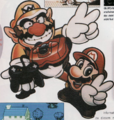User:Shokora/Work: Difference between revisions
mNo edit summary |
|||
| (156 intermediate revisions by 3 users not shown) | |||
| Line 1: | Line 1: | ||
{|class="notice-template" style="background:#AFEEEE;margin:.5em 2%;padding:0 1em;border:1px solid #000;width:95%" | |||
= | | | ||
[[File: | It is advised that any part of this user's own work is '''not copied and used''' on any other page. | ||
[[File:WL4 | |} | ||
[[File:Wario Bucks.svg|x200px]] | |||
[[File:WL4 Art Blue Crystal.svg|100px]] | |||
==Early iterations== | |||
While the [[Virtual Boy]] was still known by its development name VR-32, it was already being hinted that [[Wario]] was to have a major game appearance on the system. A [[Nintendo Power]] volume in December 1994 revealed computer-generated screenshots showing Wario in a virtual-reality atmosphere, with a caption asking ''"How would you like to meet Wario in person, face-to-face, eye-to-eye?"''<ref>Nintendo Power volume #67, December 1994, pg 87</ref> It is based on an artwork of Wario from ''[[Wario Land: Super Mario Land 3]]''. | |||
In early 1995 at the Winter {{wp|Consumer Electronics Show}} in Las Vegas, a single level demo of ''[[VB Mario Land]]'' was shown, demonstrating a side-scrolling game whith three-dimensional aspects such as moving from the background to the foreground and areas with a top-down view. A Wario head figure was shown within the demo.<ref>[[:File:VBML Tech Demo.ogv|Tech demo of ''VB Mario Land'' from Winter CES 1995]]</ref> Additionally, artwork of [[Mario]] and Wario holding a Virtual Boy was also shown at the Consumer Electronics Show. | |||
<center><gallery> | |||
{{ | VR32 Wario Nintendo Power.jpg|Wario in a virtual reality atmosphere, as shown in early Virtual Boy concepts | ||
VBMario.png|''[[VB Mario Land]]'' demo showing a Wario head as a villain | |||
Wario Virtual Boy Artwork - Nintendo Power.png|Artwork of Wario and Mario with a Virtual Boy | |||
</gallery></center> | |||
''VB Mario Land'' was absent from {{wp|E3 1995}} in June and went unreleased. However, ''Virtual Boy Wario Land'' was first revealed at the E3 event under the title '''''Wario Cruise'''''<ref name="E3 catalogue">Nintendo products catalogue, May 1995, pg 34</ref>, and uses similar concepts to the ''VB Mario Land'' demo such as moving between the background and foreground of a level. The game was referred to as ''Wario Cruise'' very close to release, as shown in the upcoming game schedules of Nintendo Power issues up to a month before the United States release in November 1995.<ref>Nintendo Power volume #77, October 1995, pg 105</ref>. The logo for Wario Cruise was also printed on the back of the standard Virtual Boy system packaging as a 'coming soon' promotion, and the "WC" abbreviation remained in the game's final serial code. | |||
In an {{wp|EB Games|Electronics Boutique}} catalogue in late 1995, a prototype box art for the game gave it the title '''''Wario's Treasure Hunt'''''<ref>Electronic Gaming Monthly issue #76, November 1995, pg 182</ref>. This catalogue was also using images of the Virtual Boy packaging which contained the ''"Wario Cruise"'' title, which suggests that both pre-release titles were being used at the same time. | |||
{{ | |||
<center><gallery> | |||
< | VBWL-Beta Logo.png|''Wario Cruise'' logo | ||
{|width=100% | VBWL-Beta Box Cover.jpg|''Wario's Treasure Hunt'' prototype boxart | ||
! | </gallery></center> | ||
! | |||
==Early builds== | |||
Four builds of the game are known to exist, which are most easily identified by the different designs of the heads-up displays (HUD) at the bottom of the screen. | |||
[[File:VBWL prerelease HUDs.png|center]] | |||
The earliest build seen in footage at E3 1995 show that stages originally didn't feature [[key]]s, and the elevator at the end of stages were already open. Wario's warp pipe animation was not yet functioning, and the screen instead faded to black between rooms. The animation when ground pounding enemies was different, with no explosion effect like the final game.<ref>P, Anthony (January 30, 2017). [https://www.youtube.com/watch?v=Op5EkC7GbxQ&t=9294s E3 1995]. ''YouTube''. Retrieved May 3, 2022.</ref> | |||
Screenshots of a second build seen in magazines around September 1995 first showed a space for the key in the HUD, and the coin counter was changed to four digits. A third build had a different coin design in the HUD, and used digits more resembling the in-game text. | |||
In the November 1995 {{wp|Nintendo Space World|Famicom Spaceworld}} official guidebook, screenshots of both the third and final build were published together.<ref>Famicom Spaceworld official guidebook, November 1995, pg 10 & 28</ref> | |||
{|width=100% class="wikitable" | |||
! Pre-release | |||
! Final | |||
! Notes | |||
|- | |- | ||
| | |[[File:VBWL S1 prerelease.png|300px]] | ||
|[[File:VBWL S1 final.png|300px]] | |||
|The floor in [[Stage 1 (Virtual Boy Wario Land)|Stage 1]] used to be positioned lower, and spikes weren't visible at the bottom of pits. The low amount of time at this point in the level suggest that the time limit used to be five minutes rather than twenty. | |||
|- | |||
|[[File:VBWL S2 prerelease.png|300px]] | |||
|[[File:VBWL S2 final.png|300px]] | |||
( | |The earliest known build of the game showed what was to become [[Stage 2 (Virtual Boy Wario Land)|Stage 2]]. Elevators previously lacked a door and were open by default without requiring a key. The positioning of background objects was changed and a [[? Block]] was added. | ||
|- | |||
|[[File:VBWL S5 prerelease.png|300px]] | |||
|[[File:VBWL S5 final.png|300px]] | |||
|In [[Stage 5 (Virtual Boy Wario Land)|Stage 5]], the [[Flying Fowl]] enemies had a different design with spikes. The position of blocks and [[Chippy]] enemies was also changed. | |||
|- | |||
|[[File:VBWL S5-2 prerelease.png|300px]] | |||
| | |[[File:VBWL S5-2 final.png|300px]] | ||
|In a separate build of Stage 5, the [[Chippy]] enemies have a different design with more prominent eyebrows. The positioning of background objects and platforms was also changed and the floor is positioned lower. | |||
|- | |||
|[[File:VBWL S9 prerelease.png|300px]] | |||
|[[File:VBWL S9 final.png|300px]] | |||
with | |An early build of [[Stage 9 (Virtual Boy Wario Land)|Stage 9]] featured a different conveyor belt design, lacking the arrow icons. The [[Honey-Bee]] enemies previously lacked antennas. | ||
( | |- | ||
|[[File:VBWL S10 prerelease.png|300px]] | |||
|[[File:VBWL S10 final.png|300px]] | |||
|An early build of [[Stage 10 (Virtual Boy Wario Land)|Stage 10]] showed a less detailed [[Blade-Face]] enemy, consisting of an outline without its usual pattern and shading. Some background details were removed and replaced with a simple black area in the final game. | |||
and | |||
|} | |} | ||
| | ==Unused data== | ||
| | {{multiframe | ||
| | |align=right | ||
| | |1=[[File:VBWL unused level numbers.png]] [[File:VBWL level map.png]] | ||
| | |2=The unused stage map (left) with the final map (right). | ||
}} | |||
The game data contains an unused stage map showing a different arrangement to the final game. | |||
The stage numbers originally appeared to be reversed, beginning at 4-1 and ending at 1-Boss. The higher number may have indicated how deep Wario still remained under the ground, with the aim of the game being to climb higher. This early level map is also more consistent with the game's original product description at E3 1995, which indicated that ''"four dazzling, 3-D levels each feature 3 tough stages leading to the final confrontation"''.<ref name="E3 catalogue" /> The final game instead simply numbers the stages from 1 to 14. | |||
The skull graphic that indicates the boss stages was updated with shading for the final level map. Additionally, an arrow graphic stored next to the stage numbers suggests that there was a level select screen which went unused. A version number reading "/:Ver:BESTIM" can also be seen in the data. | |||
There are two unused sound files present in the game data. The first appears to be victory or stage clear music, and the other was likely used for a cutscene. | |||
{{media table | |||
|file1=VBWL unused music.mp3 | |||
|title1=Unused music | |||
|description1= | |||
|length1=0:18 | |||
|file2=VBWL unused jingle.mp3 | |||
|title2=Unused music | |||
|description2= | |||
|length2=0:30 | |||
}} | }} | ||
==References== | ==References== | ||
<references/> | <references/> | ||
Latest revision as of 08:51, October 13, 2022
|
It is advised that any part of this user's own work is not copied and used on any other page. |
Early iterations
While the Virtual Boy was still known by its development name VR-32, it was already being hinted that Wario was to have a major game appearance on the system. A Nintendo Power volume in December 1994 revealed computer-generated screenshots showing Wario in a virtual-reality atmosphere, with a caption asking "How would you like to meet Wario in person, face-to-face, eye-to-eye?"[1] It is based on an artwork of Wario from Wario Land: Super Mario Land 3.
In early 1995 at the Winter Consumer Electronics Show in Las Vegas, a single level demo of VB Mario Land was shown, demonstrating a side-scrolling game whith three-dimensional aspects such as moving from the background to the foreground and areas with a top-down view. A Wario head figure was shown within the demo.[2] Additionally, artwork of Mario and Wario holding a Virtual Boy was also shown at the Consumer Electronics Show.
VB Mario Land demo showing a Wario head as a villain
VB Mario Land was absent from E3 1995 in June and went unreleased. However, Virtual Boy Wario Land was first revealed at the E3 event under the title Wario Cruise[3], and uses similar concepts to the VB Mario Land demo such as moving between the background and foreground of a level. The game was referred to as Wario Cruise very close to release, as shown in the upcoming game schedules of Nintendo Power issues up to a month before the United States release in November 1995.[4]. The logo for Wario Cruise was also printed on the back of the standard Virtual Boy system packaging as a 'coming soon' promotion, and the "WC" abbreviation remained in the game's final serial code.
In an Electronics Boutique catalogue in late 1995, a prototype box art for the game gave it the title Wario's Treasure Hunt[5]. This catalogue was also using images of the Virtual Boy packaging which contained the "Wario Cruise" title, which suggests that both pre-release titles were being used at the same time.
Early builds
Four builds of the game are known to exist, which are most easily identified by the different designs of the heads-up displays (HUD) at the bottom of the screen.
The earliest build seen in footage at E3 1995 show that stages originally didn't feature keys, and the elevator at the end of stages were already open. Wario's warp pipe animation was not yet functioning, and the screen instead faded to black between rooms. The animation when ground pounding enemies was different, with no explosion effect like the final game.[6]
Screenshots of a second build seen in magazines around September 1995 first showed a space for the key in the HUD, and the coin counter was changed to four digits. A third build had a different coin design in the HUD, and used digits more resembling the in-game text.
In the November 1995 Famicom Spaceworld official guidebook, screenshots of both the third and final build were published together.[7]
| Pre-release | Final | Notes |
|---|---|---|
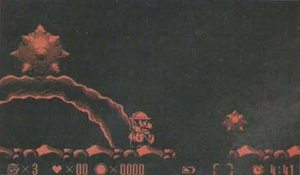
|
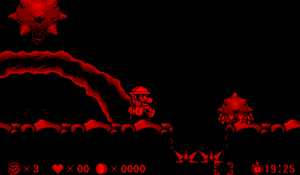
|
The floor in Stage 1 used to be positioned lower, and spikes weren't visible at the bottom of pits. The low amount of time at this point in the level suggest that the time limit used to be five minutes rather than twenty. |
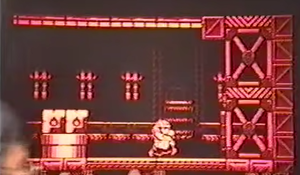
|
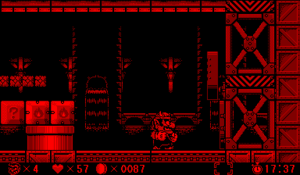
|
The earliest known build of the game showed what was to become Stage 2. Elevators previously lacked a door and were open by default without requiring a key. The positioning of background objects was changed and a ? Block was added. |
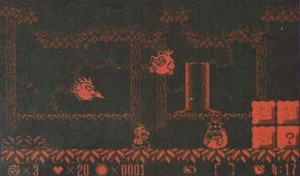
|
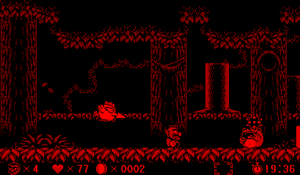
|
In Stage 5, the Flying Fowl enemies had a different design with spikes. The position of blocks and Chippy enemies was also changed. |
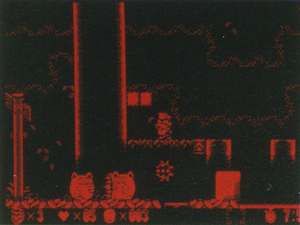
|
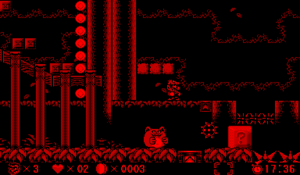
|
In a separate build of Stage 5, the Chippy enemies have a different design with more prominent eyebrows. The positioning of background objects and platforms was also changed and the floor is positioned lower. |
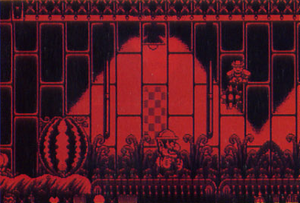
|
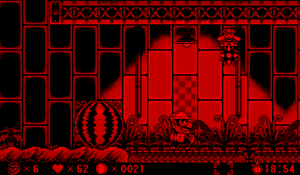
|
An early build of Stage 9 featured a different conveyor belt design, lacking the arrow icons. The Honey-Bee enemies previously lacked antennas. |
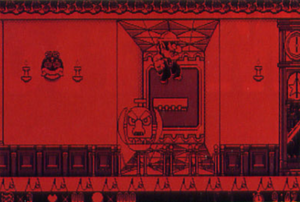
|
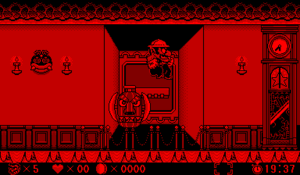
|
An early build of Stage 10 showed a less detailed Blade-Face enemy, consisting of an outline without its usual pattern and shading. Some background details were removed and replaced with a simple black area in the final game. |
Unused data
The game data contains an unused stage map showing a different arrangement to the final game.
The stage numbers originally appeared to be reversed, beginning at 4-1 and ending at 1-Boss. The higher number may have indicated how deep Wario still remained under the ground, with the aim of the game being to climb higher. This early level map is also more consistent with the game's original product description at E3 1995, which indicated that "four dazzling, 3-D levels each feature 3 tough stages leading to the final confrontation".[3] The final game instead simply numbers the stages from 1 to 14.
The skull graphic that indicates the boss stages was updated with shading for the final level map. Additionally, an arrow graphic stored next to the stage numbers suggests that there was a level select screen which went unused. A version number reading "/:Ver:BESTIM" can also be seen in the data.
There are two unused sound files present in the game data. The first appears to be victory or stage clear music, and the other was likely used for a cutscene.
| File info 0:18 |
| File info 0:30 |
References
- ^ Nintendo Power volume #67, December 1994, pg 87
- ^ Tech demo of VB Mario Land from Winter CES 1995
- ^ a b Nintendo products catalogue, May 1995, pg 34
- ^ Nintendo Power volume #77, October 1995, pg 105
- ^ Electronic Gaming Monthly issue #76, November 1995, pg 182
- ^ P, Anthony (January 30, 2017). E3 1995. YouTube. Retrieved May 3, 2022.
- ^ Famicom Spaceworld official guidebook, November 1995, pg 10 & 28



